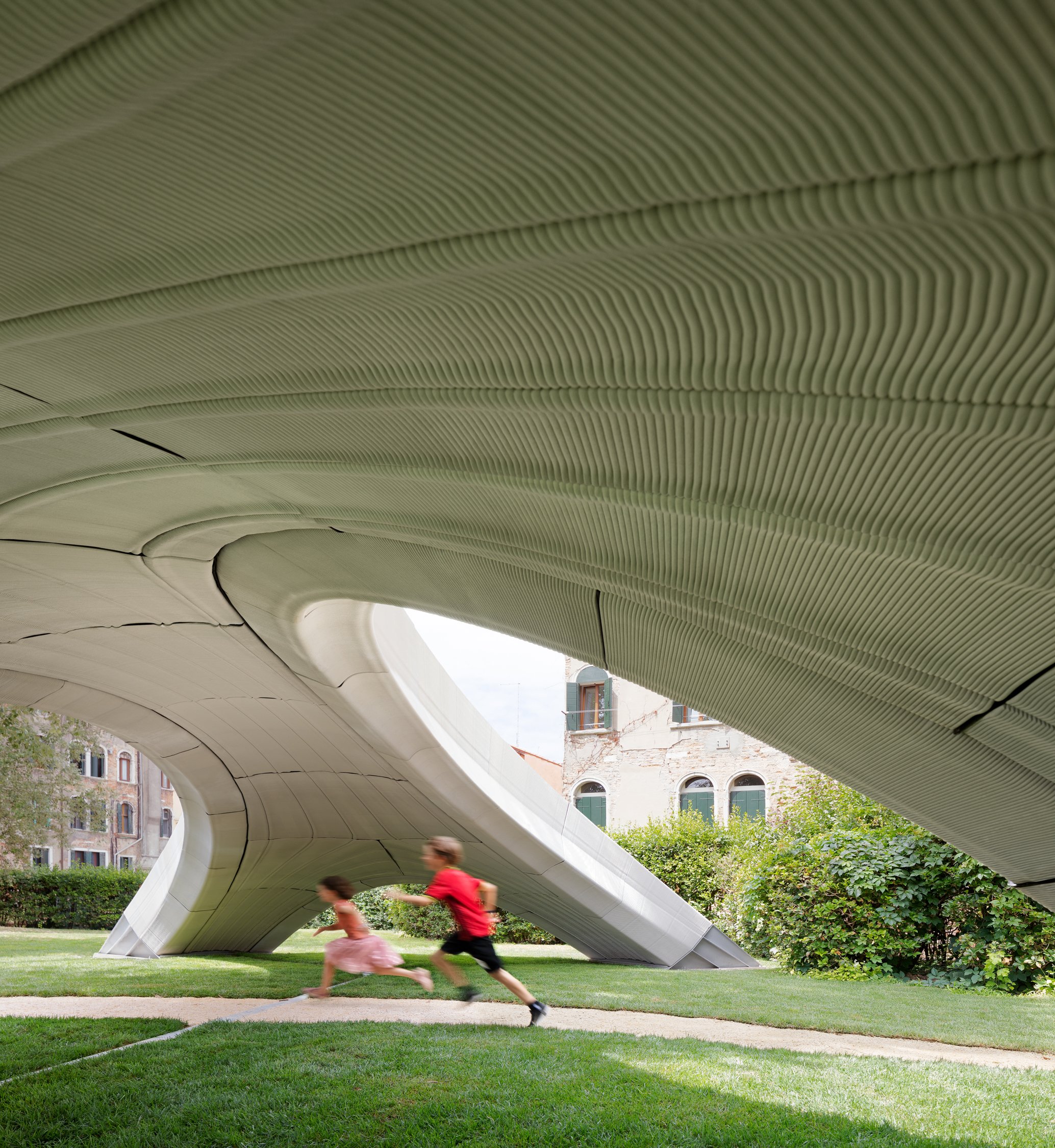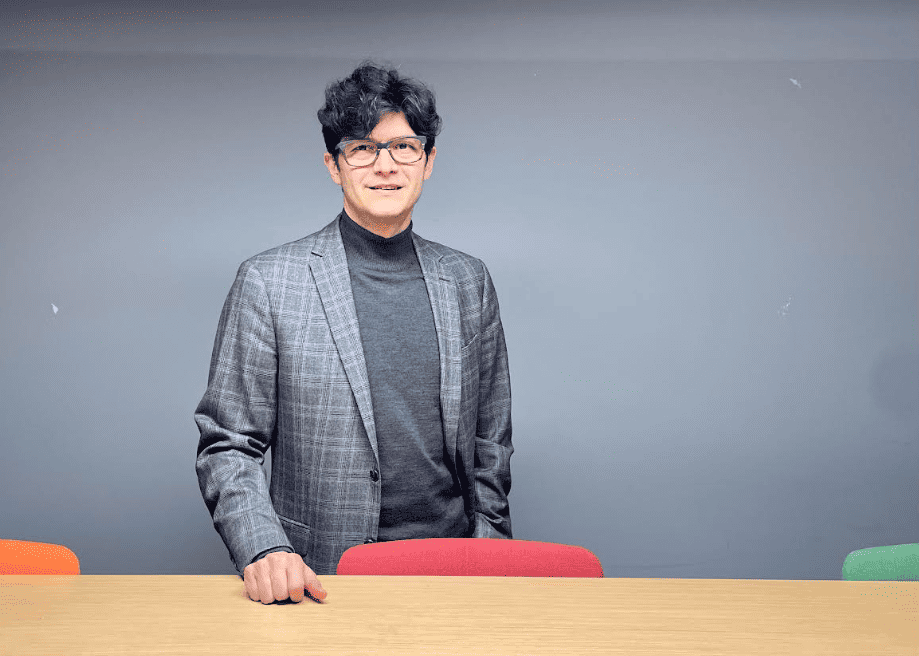
A Swiss-Austrian partnership’s 3D-printed concrete bridge was unanimously selected as the first AJ100 Innovation of the Year winner by a panel of judges from The Architects’ Journal, a British architecture magazine. The jury praised the lightweight design, which avoids waste. Best of all, the bridge can also be taken apart and rebuilt elsewhere.
The 3D-printed concrete bridge was built as Project Striatus for the Venice Architecture Biennale and was on display at the Giardini della Marinaressa until November 2021. ‘Striatus’ in Latin means ‘grooved with grooves’ and refers to the production-related surface texture of concrete 3D printing.
It is a pedestrian bridge that spans an area of 16 by 12 meters in an arched shape. Characteristic of the shape is a bifurcation on both sides, giving the bridge four access points. To make the slope passable, the accesses are organized with wooden stairs. The bridge is a response to the massive CO2 emissions in concrete construction and was designed according to the principles of “reduce, reuse and recycle.”
Construction method from antiquity
What is revolutionary about the 3-D printed bridge is the combination of a traditional technique with advanced computer design, engineering and robotic fabrication technologies. The bridge’s vault is based on a traditional construction method used in ancient times. Consider the dome construction of the Pantheon in Rome. The arches were defined using methods originally developed for the structural evaluation of historic masonry vaults. Examples include limit analysis methods, equilibrium methods, and shear network analysis.
The Block Research Group (BRG) of ETH Zurich and the Zaha Hadid Architects Computation and Design Group (ZHACODE) were involved in the design of the 3D printed bridge. It was implemented in collaboration with Innsbruck spin-off incremental3D (in3D) and building materials producer Holcim. The jury’s praise: “Architects tend to equate innovation with apps. What I like about it is that it’s a fully integrated view, from materiality to printed structures to aesthetics, and it promises a massive reduction in material costs overall.”

Exceptional efficiency
“The extraordinary efficiency of the design is explained by the additive manufacturing process,” says Johannes Megens, co-founder of in3D in Innsbruck. He and his company were involved in the development of the novel concrete printing technology. 3D printing makes it possible to optimize the shape, he said. The structural depth of components can be achieved without a solid cross-section. Material is only used where it is structurally necessary, he said. As a result, the amount of material required is less compared to casting or subtractive manufacturing methods, he said. Subtractive manufacturing methods include grinding, milling and turning. 3D printing concrete can theoretically reduce material consumption by up to 70 percent.
53 individual components
Combining traditional construction methods with innovative 3D concrete printing, the company achieved a load-bearing capacity that is not apparent from the sleek design. This is due to 53 individually designed components, each with a specific geometry and predefined position. The compressive forces within the load-bearing structure are created by the geometry and the structural members themselves, Megens explains. “Concrete can be considered an engineered stone that performs best under compression. In arch and vault structures, the material can be placed precisely so that the forces are transferred to the columns in pure compression,” Megens says.
Concrete can be considered an artificial stone that works best in compression. In arch and vault structures, the material can be placed precisely so that the forces are transferred to the columns in pure compression.
Johannes Megens, Co-Founder Incremental3D
Dry mount
To capture the horizontal shear force of the vault, a massive foundation is required. However, the pioneering Striatus project was only a temporary installation. Therefore, this function was performed by fragmentary elements connected with steel tension bands. Mortar is not needed for the construction of the 3D printed bridge. The blocks were dry-assembled. Neoprene pads are placed between the blocks to compensate for local unevenness and avoid local stress concentrations. A method reminiscent of the use of lead plates or soft mortars
This method is reminiscent of the use of lead sheet or soft mortar in historic masonry construction.

3D concrete printing technology
Conventional concrete bridge construction uses steel reinforcement to increase load-bearing capacity. Concrete from the 3D printer is not yet suitable for reinforcement – even though there are already initial approaches. The traditional construction method and the specially developed 3D printing technology provide the necessary stiffness, and reinforcement can be omitted. This is good insofar as the CO2 impact of the reinforcement is large, explains Megens. Its production generates more than ten times as much carbon per unit mass as standard concrete.
In3D’s proprietary 3D concrete printing technique foresees that blocks are printed in layers and at right angles to key structural forces to create compression.
Short construction time
Overall, construction of the 3D printed bridge, including pouring the foundation, assembly, and installing the wooden stairs and deck, took only 35 days. 3D concrete printing is relatively fast. For example, it took only 84 hours to produce all 53 blocks. With the pioneer product, the blocks still had to be printed in a controlled environment because it needs a certain air temperature and humidity. However, he says there is already talk of developing mobile product forms that can be produced locally. This would eliminate transportation costs and reduce CO2 emissions.
Reuse and recycle
An interesting side effect of the vault construction method is that it is easily dismantled, whereby the dismantling is done in the same way as the construction. You lift the bridge slightly so that the blocks can be loosened and easily removed. This would allow the bridge to be rebuilt elsewhere. The design ensures that the 3D blocks are subjected to low stress during their use. Structural integrity is maintained. The external fasteners are easily accessible and can be easily maintained. This results in a longer service life of the entire structure.
By eliminating steel reinforcement, the 3D printed bridge is made entirely of concrete. Thus, the blocks can be easily crushed and recycled.








